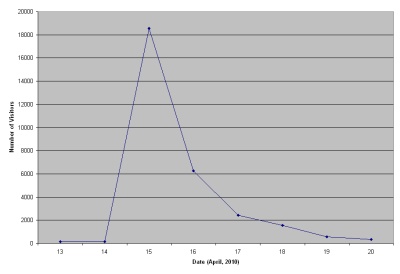| STD Wizard® | Are you at risk for an STD? |
CNN Article Shows Potential of STD WizardOn April 15th, 2010 (a Thursday), CNN wrote and published an article related to STDs (sexually transmitted diseases) on their website. The article title was "The downside of 'friends with benefits'". It included a link to the STD Wizard. We experienced a huge increase in usage of the STD Wizard resulting from the link in the article. The STD Wizard displays web pages as it dialogs with the user to determine which screening tests to recommend. The average number of pages served was 1,008 per day during the previous week. The number served during the approximate 24 hour period after the article was 211,540 pages! That's a huge increase. We have had some other incoming links, but nothing like the impact of this CNN article. The server notified us by email that there was increased activity. At first, we were somewhat perplexed, and even worried some that maybe the server was malfunctioning or even that we might be under attack. It was not until the morning of the 16th that an apache log file analysis made clear what had happened. It showed the incoming links from the article. The server reports a "load average", which is normally close to zero. During much of the 15th, the load average was around six, which is quite high. However, the server performed well during the entire time. We used the STD Wizard once as a test during the heaviest period during the afternoon, and it worked quickly and smoothly. The apache log showed no errors. The CNN article gave us the opportunity to conduct a much-needed real-world stress test, and it passed. We keep track of the number of visitors who start and finish the STD Wizard. There was an average of 52 per day who started in the previous week. On April 15th, the day of the article, 13,270 started! The previous week, 310 of the 365 who started also finished, or 84.9%. Of the 13,270 who started Thursday the 15th, 10,578 finished, or 79.7%, 5.2% lower than the previous finish rate. Some users may have clicked on the link just to see, which would explain the 5.2% lower finish rate. Here is a listing of the number of visitors, pages, hits, and traffic during the period. It spikes dramatically on the 15th, and stays high for days after.
The number of visitors in April, 2010: 
Here's another report with the number of STD Wizard starts and finishes (user gets recommendations). This is based on a different log file analysis system that actually determines if a user starts the wizard, not just viewed some introductory pages:
We don't have demographics on who used the program, but we think many users are younger people at risk of having an STD. The CNN article encouraged some 15,000 people to get scientifically-based STD screening recommendations, based on their risk factors. |